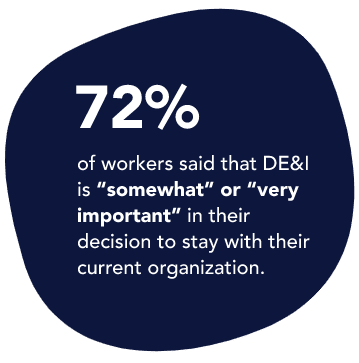How to Reduce Employee Turnover in 2025: 12 Strategies that Work

Let’s face it … employee turnover is costly.
So if you’re looking for hard, empirical data on how to reduce employee turnover, look no further than the Workhuman-Gallup Report, “Unleashing the Human Element at Work: Transforming Workplaces Through Recognition” for guidance.
In one of the report’s most stunning findings, it found that creating a culture of recognition can save a 10,000-employee company up to $16.1 million in employee turnover costs annually.
That’s in addition to the cost-savings that accrue from boosted employee engagement and productivity.

When organizations fail to have a vibrant, intentional employee recognition program in place, the impact – including an increase in employee turnover – is large and far-reaching, not to mention expensive.
As the Gallup report points out, “Experiencing consistently low levels of recognition is a drain on the employee experience and workplace culture that can have serious repercussions …
When organizations fall short on showing employees they are valued, they risk losing their employees altogether.”
The report goes on to note that employees who receive recognition only a few times a year from a manager, supervisor, or other leader are 74% more likely to report that they do not plan to be at their organization in one year.
As the Gallup report reminds us, employee recognition brings the “human” element to the workplace, setting the tone for the entire employee experience.
It points out that when organizations get recognition right, employees are more committed, engaged, and connected to their workplace culture.
They also have stronger working relationships, and feel a sense of belonging.
Those factors – and others – add up to lower turnover.
Of course, this all takes on a renewed importance and poignancy in a period when many employees are working remotely – either full- or part-time. In this dynamic, the need for connection and community is more critical – and more elusive.
That’s where the power of employee recognition can bolster an organization’s retention efforts.

4 ways recognition improves employee retention
A Workhuman® iQ survey of 2,268 full-time workers across the U.S., Canada, and Ireland pointed to four reasons why recognition can help organizations improve employee turnover and keep their valuable talent.
1. Recognition strengthens connection to your company culture – while reducing burnout.
When employees have a strong connection to company culture, it drives a sense of purpose and collaboration, reduces burnout, and is strongly associated with decreased employee turnover.
In short, when workers are recognized and thanked, they feel more connected and are more likely to stay with your organization – and that means fewer employees leave.
2. Recognition supports and advances your diversity, equity, and inclusion (DE&I) initiatives.

Making DE&I central to your organization’s DNA has a profound and very real power to attract and retain the kind of top talent your organization needs to thrive.
Knowing that an organization is genuinely committed to DE&I as one of its company’s values is a key consideration for many of your most valued employees.
The Workhuman survey findings bear this out: 72% of workers said that DE&I is “somewhat” or “very important” in their decision to stay with their current organization.
And – perhaps just as important – demonstrating a strong commitment to DE&I initiatives also has a significant impact on your ability to hire the kind of top talent your organization will need in the future.
What’s the best way to give more than just lip service to your DE&I initiatives?
Operationalize them through a unified, cohesive employee recognition program. Such programs are open to all and thereby engage everyone in a social experience – creating a more inclusive culture where people want to stay.
3. Recognition builds your work community by celebrating life events.
Why is community important? Bringing people together from across your organization deepens social connections, gives them a sense of belonging, and builds a culture that people want to be a part of – and stay a part of.

That’s why an employee recognition program that embraces community celebrations and life events is an important tool in retaining valuable employees.
Learn more about Life Events and Community Celebrations from Workhuman.
According to a Workhuman survey report, remote workers employed at companies that commemorate life events feel more respected (78% vs. 58%) and appreciated (75% vs. 44%) than remote workers at companies that do not.
Forging a stronger sense of community and connection makes your organization a place where people will want to advance their long-term career paths.
4. Public recognition creates a psychologically safe, connected work environment.
Witnessing colleagues being thanked publicly makes employees feel more grateful. And that translates into other benefits such as greater appreciation for their achievements and a stronger connection to colleagues and culture.
When you recognize employees publicly, it also creates a psychologically safe working environment in which humans feel empowered to share opinions and ideas.
And that’s the kind of work culture which can help improve employee turnover rates.
Employees who witness moments of appreciation feel more respected at work, are more inclined to grade their manager favorably, and report less burnout and stress.
The more you can amplify and socialize recognition, the more impact it will have across your organization.
Those are the kinds of benefits that will greatly reduce high employee turnover.

Employee turnover – its impact on business metrics
“Social recognition is an investment with quantifiable returns: increased engagement, productivity, quality, and profitability; decreased employee turnover and absenteeism,” note Eric Mosley and Derek Irvine in their book, “Making Work Human.”
It’s true. Countless studies and volumes of research have proven the impact recognition has on many key business metrics that shape your bottom line. Companies focused on social recognition are proven to increase employee job satisfaction, drive psychological safety, improve motivation, and retain employees.

See also: Employee Turnover vs Attrition - What Are They & How Are They Different?
Why is increasing employee retention important?
How would you feel about reducing employee turnover at your organization? I don’t know about you, but most HR professionals I know would jump at the chance. In fact, figuring out ways to reduce employee turnover is without a doubt one of the most intense challenges facing most HR professionals today.
According to a LinkedIn surveyOpens in a new tab, the average annual employee turnover rate is about 11%. With that in mind, here are a dozen tips on how you can slow down the revolving door at your company. Some may be familiar, some may be new to you, but all should help inspire long-term loyalty and improve your employee turnover rate.

How to Reduce Employee Turnover - 12 Strategies that Work
1. Carefully consider the hiring process.
The best way to ensure employees don’t leave you is to make sure you are hiring the right employees to begin with. Define the role and job description clearly — both to yourself and to the candidates. And then be absolutely sure the candidate is a fit, not only for the job, but for your company culture.
And perhaps just as important, be sure your onboarding process for new employees is one that sets them up for success for years to come.
2. Make the hard choice on letting employees go
As the old saying goes, “a stitch in time, saves nine.” The same goes for parting ways with employees when necessary.
Sometimes even when you follow the advice above, you get an employee who — no matter what you try to do — isn’t going to work out.
And no matter how effective they might be at their actual work, an employee who isn’t enriching your culture creates “culture debt.”
They will do more damage than good by having a negative impact on your company.
3. Keep compensation and benefits current.
Be sure that you are paying employees a fair going wage for their work (or better) and offer them a competitive salary and benefits. If you don’t, can you really blame them for ditching you?
This might seem like a no-brainer, but you’d be surprised how few companies offer competitive pay and raises that keep up with employee performance, development, and rising worth.
4. Encourage generosity and gratitude.
Encourage positive, social behavior in your employees. When they are given the opportunity to connect with one another through acts of connection and appreciation, employees will be healthier, happier, and less likely to fly the coop.
And by encouraging them to be on the lookout for good behaviors to commend, you give people a sense of ownership of the company.
5. Recognize and reward employees.
As we explored at length above, a key way to reduce employee turnover is to show your employees they are valued and appreciated.
How? By offering them true, real-time employee recognition that celebrates their achievements and efforts.
Of course, the best way to do this is through a comprehensive, strategic employee recognition program – once that leverages technology to amplify recognition and broadcast it throughout your company.
That way, everyone can see what your organization’s culture values, participate in congratulating and reinforcing those values, and be inspired to emulate them.

Making work more human through employee recognition drives results by capturing, amplifying, and echoing public recognition moments across the organization.
When employee recognition is specific, social and supported by tangible rewards, you, too, will be rewarded with long-term employee loyalty.
6. Offer a flexible, healthy work life balance.
Today – more than ever – employees crave a flexible, healthy work life balance.
In fact, a Boston College Center for Work & Family studyOpens in a new tab found that 76% of managers and 80% of employees indicated that flexible work schedules had positive effects on retention. And more and more companies know it.
That means, if you’re not helping employees achieve a strong work life balance – one that offers flexibility around work hours and locations – they might easily leave you for someone who will.
7. Pay frequent attention to employee engagement.
This one sounds obvious, but for too many leaders, interest in engagement is limited to the results of annual engagement surveys.
It’s not enough to simply gather employee feedback by conducting an engagement survey once a year.
Given the pace of change in today’s workplace, if you rely solely on an annual engagement survey, it’s safe to say the feedback you collected is pretty much obsolete.
Employee pulse surveys are an agile, modern way to tap into the heartbeat of an organization and truly understand the voice of the employee (VoE).
With frequent, ongoing pulse surveys, you can better take measure of your employees’ sentiments, and build a culture of engagement in your company all year long.
8. Prioritize employee happiness.
The notion of happy employees may sound a bit soft and squishy to many executives, but the numbers behind it are anything but.
High employee morale is a key indicator of job satisfaction, absenteeism, and alignment with values – just for starters.
Investing in the happiness of your employees will pay dividends in engagement, productivity, and yes, retention.
9. Make opportunities for development and growth.
Employees place a HUGE value on career development opportunities. In fact, there’s a direct connection between a lack of development opportunity and high voluntary turnover intentions.
If you aren’t developing your employees – and offering them a clear career path – then you aren’t investing in them. And if you aren’t investing in their career growth, why should they stay with you?
10. Clean up performance reviews.
Performance reviews offer a prime opportunity for a big win to increase trust and fortify your relationship with employees.
In fact today, even the most traditional organizations and industries are moving away from the annual review to a continuous performance management process that unfolds in the flow of work.
Because the debate isn’t really about whether traditional, isolated annual reviews are ineffective – they are. It’s about how you replace or supplement them, and with what.
That’s why forward-looking companies are overhauling reviews, and watching employee trust and satisfaction grow.
And that’s why your organization should fuel a continuous performance management culture that will give your employees a single, ongoing resource for development – one that reflects how successful work gets done.
Conversations® from Workhuman combines agile performance development with structured feedback and assessments to create a culture of connection, continuous feedback, and growth.
Frequent check-ins with managers lead to more engaged, productive employees – and that, in turn, makes them less likely to leave.
11. Provide an inclusive vision.
One key factor in employee engagement and happiness, according to experts, is to provide them with a sense of purpose and meaning in their workOpens in a new tab.
Offer employees a strong vision and goals for their work, and you’ll increase their sense of belonging and loyalty to your organization.
12. Demonstrate and cultivate respect.
Finally, don’t discount respect when it comes to creating a magnetic and positive work environment.
In fact, in one study, respect in the workplace was revealed to be a key factor in voluntary turnoverOpens in a new tab. Find ways to cultivate and nurture respect in your workplace and it will pay off in higher employee retention.
Conduct exit interviews when employees leave to see how you can improve.
Use these tips to help build a culture in your organization that will keep your employee turnover rate low, and your best employees on board and productive for years to come.

Reimagine your workplace – and reduce employee turnover
Want to cut your turnover in half – and save up to $16.1 M annually! It starts by reimagining your workplace. With the solutions of the Workhuman Platform.